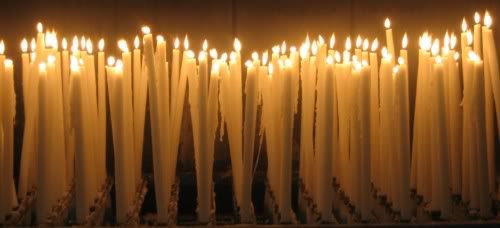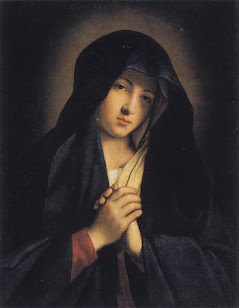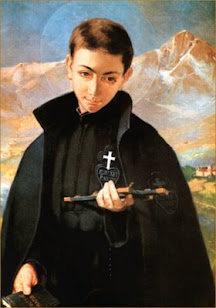When Our Lady of Mount Carmel appeared to Saint Simon Stock, she bestowed upon him the Brown Scapular of the Carmelite Order. A beautiful description of the Scapular and the devotion it signifies, written by Carmelite Sisters, is below. To read more about the Carmelite Order, please visit their site at http://www.carmelitenuns.com/.
"The original rule of the order was changed to conform to that of the mendicant orders on the initiative of St. Simon Stock and at the command of Pope Innocent IV. Their former habit of a mantle with black and white or brown and white stripes was discarded, and they wore the same habit as the Dominicans, except that the cloak was white. They also borrowed much from the Dominican and Franciscan rules. Their distinctive garment was a scapular of two strips of gray cloth, worn on the breast and back, and fastened at the shoulders. The Virgin herself, who appeared to him and promised that all who died clothed in it would be saved, gave this to St. Simon Stock. Thus arose a sodality of the scapular, which affiliated a large number of laymen with the Carmelites.
The Scapular, if worn faithfully and by a person who persists in living the Gospel that Christ taught with faith in the intercession of Mary, will guarantee the bearer salvation. The Scapular promise comes from the apparition of the Virgin to St. Simon Stock, who observed many miracles with it. Observances of miracles stemming from the proper wearing of the Scapular abound, most notably one in which a ship was caught in a grave storm and a Catholic who wore the Scapular prayed for Our Lady's intercession and subsequently tossed his scapular into the raging waters. The storm ceased instantly and the ship was saved. A Protestant family onboard, the father being a Protestant minister, was awestruck by the miracle and soon afterward converted to the Catholic faith.
The Scapular, as it is commonly known today, is merely a smaller version of the actual monastic habit worn by the friars and sisters. It has two thin brown cords that connect to two small brown rectangular patches that hang in front of and behind the wearer. Usually Catholics wear the Scapular under their regular clothing. The original rule concerning the Scapular was that it be of 100% brown wool. However, the rule today is that any suitable brown material may be used. The Scapular Medal may be substituted for the actual scapular, but the Pope who created this exception did so only for those who could not, for grave situations, wear the actual scapular. It is not meant to be a substitute for vanity.
It is notable that no recorded or approved miracles have come from anything other than the real and traditional Scapular.
Furthermore, one should note that there are many Catholic scapulars from various orders, time periods, revelations, and traditions, the most notable being the Trinity Scapular (white), the Scapular of the Immaculate Conception (blue), the Scapular of the Passion (red), and the Scapular of the Sorrows of Mary (black). These four, together with the Scapular of Our Lady of Mount Carmel (brown), are often sewn one on top of the other (with the Trinity Scapular on very top) and attached to two cords to form a Five-Fold Scapular. However, since the Carmelite Scapular is most popular and well known, any reference to "the Scapular" implies the Carmelite Scapular, which is the only scapular to carry the promise of salvation. Other scapulars have various graces associated with them or form part of special devotions.
To wear a scapular must be distinguished from enrollment. Any person can wear a Catholic scapular and may or may not obtain graces from them, depending on the faith they place in the Lord and the virtues lived in his or her life. Generally, scapulars are viewed as privileges and are usually entrusted by the Holy See to the authority of a particular order or community. Since the Carmelite Friars have authority over the Carmelite Scapular, only that Order can allow lay people to wear their scapular. The Order has since granted permission to all Catholic priests to invest or enroll Catholics in their scapular. The priest asking the Lord to grant the graces associated with the particular scapular to the Catholic that requests enrollment does this. This can take the form of a short (10 minute) prayer with the priest or can take place in a lengthy and elaborate liturgical rite."
Why pray the Rosary every day for a year?
Each time the Blessed Virgin has appeared-- whether it be to Saint Bernadette Soubirous at Lourdes; to Lucia, Jacinta, and Francisco at Fatima; or to Mariette Beco at Banneux-- she has asserted the importance, saving grace, and power of praying the Holy Rosary on a daily basis. Based upon her words, the Rosary is penance and conversion for sinners, a pathway to peace, an end to war, and a powerful act of faith in Jesus Christ. Pope Paul VI presented the Rosary as a powerful means to reach Christ "not merely with Mary but indeed, insofar as this is possible to us, in the same way as Mary, who is certainly the one who thought about Him more than anyone else has ever done."
To show us how this is done, perhaps no one has been more eloquent than the great Cardinal Newman, who wrote: "The great power of the Rosary consists in the fact that it translates the Creed into Prayer. Of course, the Creed is already in a certain sense a prayer and a great act of homage towards God, but the Rosary brings us to meditate again on the great truth of His life and death, and brings this truth close to our hearts. Even Christians, although they know God, usually fear rather than love Him. The strength of the Rosary lies in the particular manner in which it considers these mysteries, since all our thinking about Christ is intertwined with the thought of His Mother, in the relations between Mother and Son; the Holy Family is presented to us, the home in which God lived His infinite love."
As Mary said at Fatima, "Jesus wants to use you to make Me known and loved. He wishes to establish the devotion to My Immaculate Heart throughout the world. I promise salvation to whoever embraces it; these souls will be dear to God, like flowers put by Me to adorn his throne."

Subscribe to:
Post Comments (Atom)











0 comments:
Post a Comment
Thanks for leaving a comment. If you wish to submit a prayer request, however, please do so above, using the "Contact" tab.